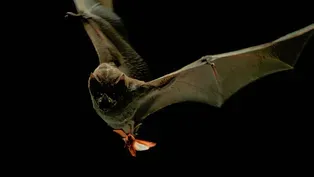
The Epic Migration of Monarch Butterflies
Clip: Episode 2 | 4m 58sVideo has Closed Captions
Monarch butterflies winter in the fir forests of Michoacan, Mexico, after an epic migration.
In one of the most singular migratory events in the animal world, monarch butterflies spend their winters in the fir forests of Michoacan, Mexico. It takes multiple generations to make this trip, and when the monarchs arrive they completely cover the fir trees of the high altitude forests. Conservationist Homero Gonzalez describes the meaning of these monarchs to the local culture.
Problems with Closed Captions? Closed Captioning Feedback
Problems with Closed Captions? Closed Captioning Feedback

The Epic Migration of Monarch Butterflies
Clip: Episode 2 | 4m 58sVideo has Closed Captions
In one of the most singular migratory events in the animal world, monarch butterflies spend their winters in the fir forests of Michoacan, Mexico. It takes multiple generations to make this trip, and when the monarchs arrive they completely cover the fir trees of the high altitude forests. Conservationist Homero Gonzalez describes the meaning of these monarchs to the local culture.
Problems with Closed Captions? Closed Captioning Feedback
How to Watch Bugs That Rule the World
Bugs That Rule the World is available to stream on pbs.org and the free PBS App, available on iPhone, Apple TV, Android TV, Android smartphones, Amazon Fire TV, Amazon Fire Tablet, Roku, Samsung Smart TV, and Vizio.
The scale of the crisis has recently become clear with one of the most extraordinary and closely watched insects on the planet, monarch butterflies.
[slow calming music] In the high altitude forests of Michoacan, clouds of monarch butterflies find a winter retreat in the region's rare fir trees called oyamel.
Most individual monarchs only live for about six weeks.
But when spring arrives, they set off a journey that takes four lifetimes.
I really like the idea of the generation starship.
This is a science fiction idea where a ship takes people on a journey to a distant planet, but the journey takes so long it takes multiple generations to get there.
And this really exists in the world of insects.
[slow upbeat music] Monarch butterflies do this massive migration, and take three generations to get from Mexico to Eastern Canada.
And then on the final generation, they fly all the way back down to Mexico.
Monarchs use air currents to fly up to 150 miles a day.
They'll stop to lay their eggs on milkweed, the only host plant their caterpillars can eat.
Once the next generation emerges, the young monarchs continue the journey north.
[slow upbeat music] After spending the summer in Canada, the last generation lives a full eight months longer than its ancestors, and makes the return flight all the way to Mexico.
[slow upbeat music] How does a organism that's 0.02 ounces, and less than four inches make it 2000 miles in a couple of months to then arrive in a place that they've never been before?
In fact, that their parents have never been before, their great grandparents have never been before.
The fact that it makes this journey across generations every single year is one of the coolest animal stories on the planet.
We're trying to figure out, as entomologists, why and how they actually do that.
And there's still a lot of mysteries in this process.
[slow upbeat music] Scientists speculate that an internal clock, the position of the sun, and genetic hard wiring all help with navigation.
But no one knows exactly how the monarchs find their way back to the site of their only overwintering trees in Mexico.
[Singing in Spanish] [slow dramatic music] [slow upbeat music] Monarchs have been making this spectacular migration for as many as 10,000 years.
But this ancient cycle appears on the verge of being broken, as fewer and fewer return home each year.
One of the things that's been especially conspicuous is the decrease in the numbers of migrating monarchs.
In the last several years.
The numbers have been terrifying low.
You know, down to a few thousand individuals in some of the counts.
Deforestation, climate change, and loss of milkweed, have had catastrophic effects on this natural spectacle.
In recent years, the number of returning monarchs has plummeted by up to 60%.
It may be that these highly adaptable creatures are running out of time.
The Evolutionary Race Between Moths and Bats
Video has Closed Captions
Jesse Barber and Akito Kawahara study the evolutionary arms race between bats and moths. (7m 55s)
Providing Support for PBS.org
Learn Moreabout PBS online sponsorshipSupport for PBS provided by:












